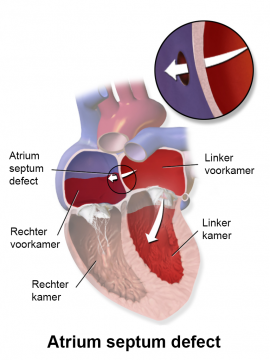Congenital heart defect
Symptoms and causes
Symptoms and causesWhat is it?
Congenital heart defects are the result of a disturbance in the development of the heart during the earliest embryonic period (2 to 12 weeks after conception). Some congenital heart defects can be camouflaged by the body for a long time and therefore only cause symptoms later in life.
Congenital heart defects can occur as part of a syndrome (e.g. Down's syndrome), but can also occur in isolation. The following congenital heart defects are the most common:
Bicuspid aortic valve
A bicuspid aortic valve (the valve between the heart and large body artery or aorta) has two valve flaps instead of three. This increases the risk of rapid wear and tear, valve leaks and/or valve constriction. There is also an increased risk of an aortic aneurysm.
Patent foramen ovale
A patent foramen ovale is a remaining tunnel that connects the right and left atria. This passage is crucial in the baby's developmental phase and closes after birth. In about 25% of people, this closure is incomplete: a patent foramen ovale.
On rare occasions, this passage can allow a clot to pass through, which can lead to a stroke.

Atrium septum defect
An atrium septum defect is a hole between the two atria. See figure.
Ventricular septum defect
A ventricular septum defect is a hole between the two chambers (ventricles). This abnormal connection causes overtaxation of the heart and can weaken it. This is how heart failure occurs.
Coarctatio
Coarctation refers to the narrowing or constriction of the body’s main artery (the aorta).
Symptoms
Usually, congenital heart diseases are detected and treated during childhood. At a later age, the only symptom a physician can hear is a heart 'murmur'. Other common symptoms include:
- fatigue
- shortness of breath
- heart palpitations
- fainting
- heart rhythm disturbances
Diagnosis and treatment
Diagnosis and treatmentHow is the diagnosis determined?
- Electrocardiogram
- Ultrasound via the chest (transthoracic ultrasound)
- Ultrasound through the oesophagus (transoesophageal ultrasound)
- CT or MRI of the heart
- Diagnostic cardiac catheterisation
Treatment
There are both surgical and non-surgical techniques for the treatment of a congenital heart defect. Because congenital defects are different in almost every patient, individual treatment is always ‘customised'. It goes without saying that it is best for you to be guided by the attending cardiologist.
A commonly used non-surgical technique for closing 'holes' is the placement of an 'umbrella'. The defect is approached with a catheter, after which a split disc can be unfolded to close the hole.
Treatment centres and specialisations
Treatment centres and specialisations
Latest publication date: 10/01/2024
Supervising author: Dr Provenier Frank




